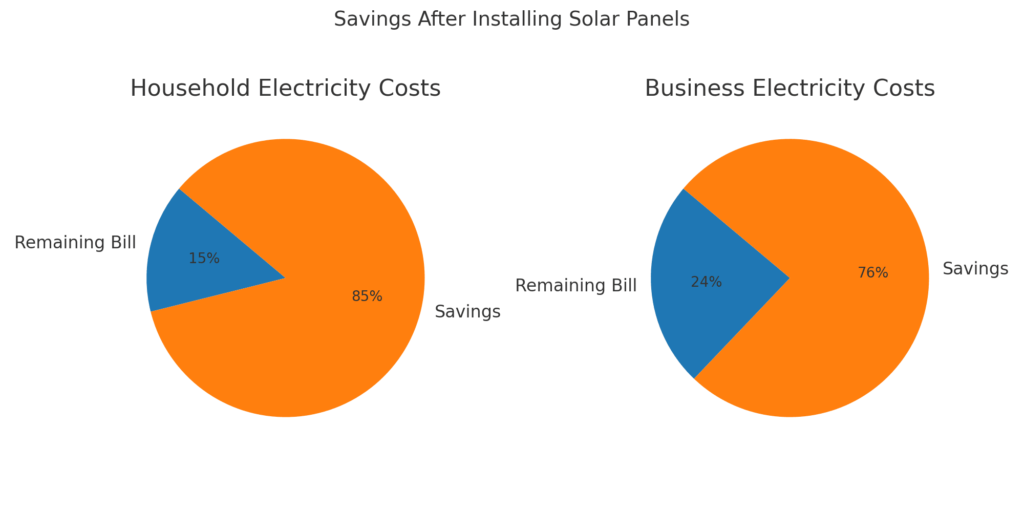In recent years, homeowners and businesses alike have started questioning their ever-rising utility costs. The shift from electricity bills to solar savings is no longer just a trend—it’s becoming a necessity. With technological advancements, government incentives, and increasing awareness of sustainable energy, many are realizing that solar power is not just an eco-friendly option but also a financially smart decision.

The Struggle with High Electricity Bills
For decades, traditional power consumption has meant relying on fossil fuel–based grids. These systems are not only harmful to the environment but also unpredictable in cost. Seasonal demand, fuel shortages, and global price fluctuations have caused electricity rates to skyrocket. Households often find themselves adjusting budgets every month to keep up with bills.
This financial strain is what pushed people to explore alternatives. And that’s where the transition from electricity bills to solar savings started to gain real momentum.
Why Solar Became the Game-Changer
Solar energy provides a sustainable, clean, and cost-efficient solution. Instead of renting power from the grid forever, homeowners can invest in their own energy production. Installing solar panels significantly reduces monthly expenses, ensuring that hard-earned money stays in the household rather than being paid out in rising bills.
The concept of moving from electricity bills to solar savings works because once the system is installed, sunlight—an unlimited resource—becomes the primary fuel. Unlike conventional power sources, sunlight is free, abundant, and renewable.
Government Policies and Incentives
One of the biggest reasons behind the shift from electricity bills to solar savings is the growing support from governments around the world. Subsidies, tax credits, and financing options have made solar accessible to the average household. In many regions, net metering policies allow solar owners to sell excess energy back to the grid, turning homes into mini power stations. This reduces payback periods and makes solar a long-term profitable investment.
Falling Costs of Solar Technology
A decade ago, solar was considered a luxury option due to its high upfront costs. Today, advancements in technology and mass adoption have brought prices down significantly. With increased efficiency of panels, better storage solutions, and declining equipment costs, the financial barrier has lowered. This affordability has accelerated the movement from electricity bills to solar savings, making solar a mainstream energy solution.
Environmental Impact and Awareness
Another factor that cannot be ignored is environmental consciousness. As climate change becomes a pressing issue, more households and businesses are taking responsibility for their carbon footprint. Switching from traditional power to solar means reducing greenhouse gas emissions and promoting cleaner air.
This moral advantage adds to the financial benefits, making the journey from electricity bills to solar savings not just about money, but also about contributing to a sustainable future.
The Role of Energy Independence
Energy independence is another attractive aspect of this transition. With frequent blackouts and rising costs, depending on a centralized power supply is becoming riskier. By moving from electricity bills to solar savings, households secure themselves against power cuts and fluctuating electricity rates. Solar panels paired with batteries allow homeowners to store energy, ensuring 24/7 availabilitelectricity bills to solar savingsy.
electricity bills to solar savings Long-Term Benefits
What makes solar truly valuable is its long-term nature. While electricity bills are a recurring monthly burden, solar panels are a one-time investment with benefits lasting 20–25 years or more. Over time, this transition ensures significant savings. For example, a family spending ₹5,000 per month on electricity could save lakhs of rupees in two decades by adopting solar.
This journey from electricity bills to solar savings represents a shift from uncertainty to stability. It’s a path that promises both financial security and environmental responsibility.
Final Thoughts
The story of moving from electricity bills to solar savings is more than just a financial upgrade—it’s a lifestyle transformation. With falling technology costs, supportive policies, and growing awareness, solar energy is no longer an alternative; it’s becoming the standard.
For families tired of unpredictable bills and businesses looking for stability, the solution is clear: investing in solar power. What once felt like a futuristic option is now an everyday reality, reshaping how we consume and pay for energy.
